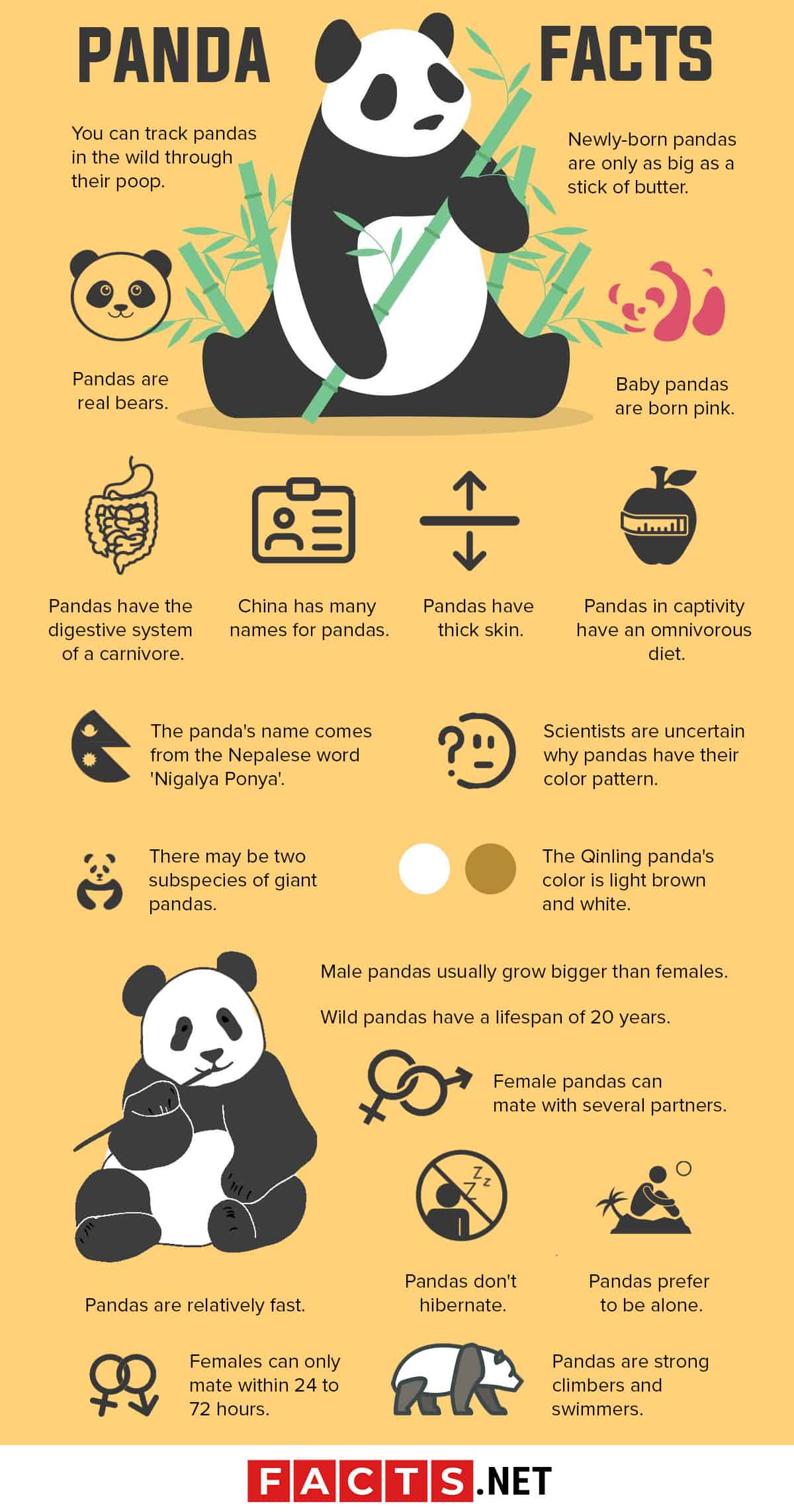How Long Do Giant Pandas Live? Unlocking The Secrets Of Panda Lifespan
Have you ever wondered how long do giant pandas live? These adorable black-and-white creatures have captured the hearts of millions worldwide, but their lifespan remains a mystery to many. Giant pandas are not just cute animals; they’re a symbol of conservation efforts and biodiversity preservation. In this article, we’ll dive deep into their world, uncovering the secrets behind their longevity and the factors that influence their lifespan.
Giant pandas are more than just a favorite at zoos—they’re an essential part of the ecosystem. Their survival is closely tied to habitat preservation and human intervention. Understanding how long these amazing creatures live can help us appreciate the challenges they face in the wild and captivity. So, buckle up, because we’re about to take a journey through their fascinating lives!
From bamboo-loving habits to their unique reproductive cycles, giant pandas have a lot to teach us about nature’s balance. Whether you’re a wildlife enthusiast or just curious about these fluffy bears, this article will provide all the answers you need. Let’s get started!
- Tarah Adkins The Rising Star You Need To Know About
- Lisa Thorner The Rising Star Whos Capturing Hearts Worldwide
Understanding Giant Pandas: A Quick Overview
Before we dive into the specifics of their lifespan, let’s talk about what makes giant pandas so special. Native to the mountain ranges of central China, these bears are known for their distinct black-and-white fur and love for bamboo. But there’s so much more to them than meets the eye.
Giant pandas are classified as endangered, although recent conservation efforts have improved their status slightly. They play a crucial role in maintaining the health of bamboo forests, which are vital for other species as well. Their diet consists almost entirely of bamboo, which makes up about 99% of what they eat.
How Long Do Giant Pandas Live in the Wild?
Life in the wild is tough for giant pandas. On average, they live between 15 to 20 years in their natural habitat. This relatively short lifespan is due to several factors, including limited food sources, harsh weather conditions, and predation. Plus, let’s not forget the ever-present threat of habitat loss.
- Is Taylor Swift Engaged The Inside Scoop Youve Been Waiting For
- Christina P The Rising Star Whos Taking The World By Storm
One of the biggest challenges for wild pandas is finding enough bamboo to sustain themselves. Bamboo forests can be unpredictable, with periodic die-offs that leave pandas struggling to survive. This is why conservation efforts focus heavily on protecting and expanding their natural habitats.
Factors Affecting Lifespan in the Wild
Several key factors influence how long giant pandas live in the wild:
- Habitat Quality: Pandas need healthy bamboo forests to thrive.
- Food Availability: A steady supply of bamboo is crucial for survival.
- Predation: Although adult pandas have few natural predators, cubs are vulnerable.
- Climate: Extreme weather conditions can make life difficult for pandas.
It’s a delicate balance, and even small changes in their environment can have significant impacts on their lifespan.
How Long Do Giant Pandas Live in Captivity?
In captivity, giant pandas tend to live longer than their wild counterparts. On average, they can live up to 25 to 30 years in zoos and breeding centers. This extended lifespan is largely due to the controlled environment and access to veterinary care.
Zoos and sanctuaries provide pandas with a steady diet of bamboo, supplemented with other nutrients to ensure their health. They also receive regular check-ups and medical attention, which helps prevent and treat illnesses that might otherwise be fatal.
Advantages of Captivity for Giant Pandas
Living in captivity offers several advantages for giant pandas:
- Access to Medical Care: Pandas receive regular health checks and treatment for any ailments.
- Stable Food Supply: They have a guaranteed source of food, which is especially important during bamboo shortages.
- Protection from Predators: Captive pandas are safe from natural predators and environmental threats.
However, it’s important to note that captivity isn’t without its challenges. Pandas in captivity may face issues like stress and reduced physical activity, which can impact their overall well-being.
The Role of Conservation in Panda Lifespan
Conservation efforts have played a significant role in extending the lifespan of giant pandas. Through initiatives like habitat restoration, breeding programs, and anti-poaching laws, scientists and conservationists have worked tirelessly to protect these incredible animals.
One of the most successful conservation programs is the Wolong National Nature Reserve in China, which serves as a sanctuary for pandas and other endangered species. The reserve provides a safe haven where pandas can live and breed without the constant threat of human interference.
Key Conservation Strategies
Here are some of the strategies used to protect giant pandas:
- Habitat Restoration: Replanting bamboo forests to provide pandas with ample food sources.
- Breeding Programs: Encouraging reproduction through controlled environments and artificial insemination.
- Community Engagement: Educating local communities about the importance of panda conservation.
These efforts have paid off, with the panda population slowly increasing over the years. However, there’s still a long way to go to ensure their survival for future generations.
What Do Pandas Eat and How Does It Affect Their Lifespan?
As we’ve mentioned, bamboo makes up the vast majority of a panda’s diet. But did you know that pandas actually have the digestive system of a carnivore? Despite this, they’ve adapted to thrive on a plant-based diet, which is quite remarkable.
However, relying almost entirely on bamboo has its drawbacks. Bamboo is low in nutrients, which means pandas need to eat a lot of it to meet their daily energy needs. This can be challenging, especially during periods when bamboo is scarce. In fact, some researchers believe that dietary limitations may contribute to the shorter lifespan of wild pandas.
The Bamboo Diet: Pros and Cons
Here’s a quick breakdown of the pros and cons of the panda’s bamboo-heavy diet:
- Pros: Bamboo is abundant in their natural habitat and provides a steady food source.
- Cons: Low nutrient content means pandas must consume large quantities to survive.
Understanding the panda’s dietary needs is crucial for both wild and captive populations. By ensuring they have access to high-quality bamboo and supplemental nutrition, we can help improve their overall health and lifespan.
Reproductive Challenges and Their Impact on Lifespan
Giant pandas face unique reproductive challenges that can affect their lifespan. Female pandas are only fertile for a few days each year, making successful mating a rare occurrence. This limited breeding window, combined with a high rate of cub mortality, makes it difficult for panda populations to grow.
In captivity, scientists have developed techniques to improve breeding success, such as artificial insemination and specialized care for newborn cubs. These efforts have helped increase the number of pandas born in zoos and breeding centers, contributing to the overall population.
Challenges in the Wild
In the wild, pandas face additional challenges when it comes to reproduction:
- Small Population Size: With fewer pandas in the wild, finding a mate can be difficult.
- Fragmented Habitats: Human activities have divided panda habitats, making it harder for them to roam and find partners.
Addressing these challenges is essential for ensuring the survival of giant pandas in the wild.
Common Myths About Giant Pandas
There are many myths surrounding giant pandas, some of which can be misleading. Let’s debunk a few of the most common ones:
Myth #1: Pandas are Lazy – While it’s true that pandas spend a lot of time eating and sleeping, this behavior is actually a survival strategy. Their low-energy diet requires them to conserve as much energy as possible.
Myth #2: Pandas are Solitary Creatures – Although pandas are often seen alone, they do interact with each other during mating season and when raising cubs.
Myth #3: Pandas are Dangerous – Despite their size and strength, pandas are generally peaceful animals that prefer to avoid conflict.
Why Debunking Myths Matters
Dispelling these myths helps us better understand giant pandas and the challenges they face. By separating fact from fiction, we can focus on the real issues affecting their survival, such as habitat loss and climate change.
How Can You Help Protect Giant Pandas?
Protecting giant pandas is a global effort that requires the participation of individuals, organizations, and governments. Here are a few ways you can make a difference:
- Support Conservation Organizations: Donate to groups working to protect pandas and their habitats.
- Reduce Your Carbon Footprint: Climate change affects bamboo forests, so doing your part to combat it can help pandas indirectly.
- Educate Others: Spread awareness about the importance of panda conservation and the challenges they face.
Every little bit helps, and together we can ensure that future generations have the opportunity to marvel at these incredible creatures.
Conclusion: The Future of Giant Pandas
In conclusion, the lifespan of giant pandas is influenced by a variety of factors, including habitat, diet, and conservation efforts. While wild pandas typically live 15 to 20 years, those in captivity can reach 25 to 30 years thanks to improved living conditions and medical care.
By addressing the challenges facing giant pandas, such as habitat loss and reproductive difficulties, we can help extend their lifespan and ensure their survival. Whether through supporting conservation initiatives or simply spreading awareness, each of us has a role to play in protecting these amazing animals.
So, what will you do to help the pandas? Leave a comment below and let us know how you plan to get involved. And don’t forget to share this article with your friends and family to spread the word about panda conservation!
Table of Contents
- Understanding Giant Pandas: A Quick Overview
- How Long Do Giant Pandas Live in the Wild?
- Factors Affecting Lifespan in the Wild
- How Long Do Giant Pandas Live in Captivity?
- Advantages of Captivity for Giant Pandas
- The Role of Conservation in Panda Lifespan
- Key Conservation Strategies
- What Do Pandas Eat and How Does It Affect Their Lifespan?
- The Bamboo Diet: Pros and Cons
- Reproductive Challenges and Their Impact on Lifespan
- Challenges in the Wild
- Common Myths About Giant Pandas
- Why Debunking Myths Matters
- How Can You Help Protect Giant Pandas?
- Conclusion: The Future of Giant Pandas



Detail Author:
- Name : Cristopher Frami
- Username : fharber
- Email : darien.bruen@franecki.com
- Birthdate : 1988-07-02
- Address : 9273 Parker Estates Suite 839 West Codybury, VT 72006
- Phone : 919.449.0940
- Company : Pollich-Watsica
- Job : Word Processors and Typist
- Bio : Ut quaerat libero consectetur voluptatem atque iure. Odit sunt nemo nemo nesciunt aspernatur. Ad dolores repellendus qui fuga facilis.
Socials
instagram:
- url : https://instagram.com/jorge_xx
- username : jorge_xx
- bio : Perspiciatis qui qui sint. Ut nisi quo qui a quo.
- followers : 3999
- following : 156
tiktok:
- url : https://tiktok.com/@jorge6902
- username : jorge6902
- bio : Odio aperiam dolor quibusdam praesentium molestiae porro.
- followers : 1236
- following : 1696